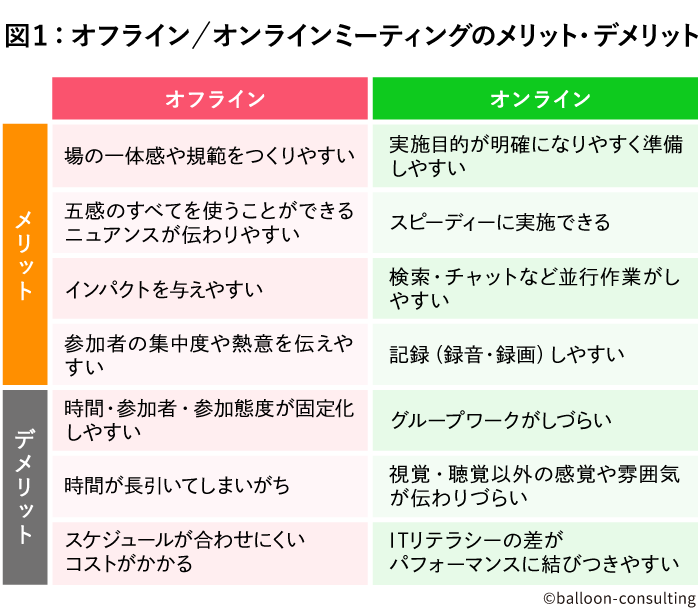コロナ禍によって、図らずも日本社会に浸透したリモートワークの常態化が、私たちの働き方に新たな課題を突きつけています。
柔軟なスケジューリング、通勤負荷の軽減などのメリットがある一方で、リモートゆえの創発の難しさや、コミュニケーションの希薄化がチームのクリエーティビティーに与える影響など、多くのことが社会全体で浮き彫りになってきています。
アフターコロナでも、確実に私たちの生活の一部となる、リモートワーク。
そのリモートワークの成否を分ける存在が、実は、「ファシリテーター」なのです。
前編では、オンラインミーティングで創造的なコラボレーションを生み出すためのポイントを、そのカギとなる「ファシリテーター」の役割に焦点を当てて解説します。
今、リモート環境における創発が課題に
業務報告や情報共有には問題ないが、イチからアイデアを生み出すようなコラボレーションは難しい―。
リモートワークの長期化に伴い、オンラインミーティングについてよく聞かれる悩みです。
Buffer & AngelListが今年実施した、「世界各国のリモートワーカーに対する調査※1」においても、一番の問題として「コミュニケーション/コラボレーション」が挙げられています。
オンラインとオフラインでは何が違うのか、まずは、それぞれのメリット・デメリットを整理してみました。

図1:オフライン/オンラインミーティングのメリット・デメリット
自分のアイデアがチームメンバーにどう思われているのか、さまざまなアイデアの中で多くのメンバーが支持するのはどの案なのか、言葉や文字だけでなく、表情や空気感なども含めた、合意形成のために重要となる「一体感の醸成」。
一番の課題は、これをオンラインミーティングで実現するのが難しいことです。
それを克服するために、ウェブ会議システムにはさまざまな機能が搭載されていますが、リテラシーの個人差もあるため、多くの日本企業では使いこなせていない状況です。
さらに、リモートワークが定着してくると、すでにオフラインで十分に交流があるメンバーだけでなく、リモート環境で初めて出会ったメンバーとプロジェクトを推進していく機会も増加していきます。
そのような環境の中で、個々のチームメンバーの能力を十分に引き出しながら、高いレベルのコラボレーションを実現させるスキルとマインドセットの標準装備という、高度なスキルが今、求められているのです。
オンラインミーティングで重要性を増すファシリテーター
リモート環境においては「あうんの呼吸」によって物事が円滑に進むことが期待できない分、リアルでのコミュニケーション以上に、チームメンバー間の明確な役割分担と、きめ細かい意思疎通を必要とします。
また、良好なリレーションシップを維持するために、オフライン時以上の相互の配慮も重要です。それらを担う司令塔の役割を果たすのが、ファシリテーターです。
円滑なミーティングを運営するためにファシリテーション能力が重要であることはリアルの場でも同様ですが、オンラインミーティングにおいてはその巧拙の差が、よりチーム全体のパフォーマンスに直結します。オンラインミーティングにおけるファシリテーターの役割は、以下の三つです。
1.ミーティング全体のPDCA設計
「段取り八分」という言葉がありますが、ミーティング中だけでなく、その事前準備、および事後のアクションの設計が、円滑なプロジェクト運営のためには不可欠です。ミーティングのゴール設計およびアジェンダ設定、その時間配分、そして事前作業の指示もファシリテーターの仕事です。
アジェンダの設定に当たっては、会議の時間内で終わらせることができる分量・内容かどうかに留意することが必要です。また、重要度、緊急度の高いものから順に議論をすることで、重要なことが議論できずに終了時間が来てしまう、いわゆる「尻切れトンボ」のリスクを低減させる工夫も必要でしょう。また、長時間のミーティングの際は60分ごとに10分程度の休憩を入れるなど、メンバーのコンディションを維持するための配慮も忘れないようにしましょう。
限られた時間の中で質の高いコラボレーションを実現するためには、ミーティング当日のディスカッションに必要な事前資料の読み込みや、チームメンバーそれぞれの意見や課題意識を、メールやチャットなどで収集しておくことも必要です。さらに、それらの事前準備をメンバーに遵守させることも求められます。
ミーティングの終了後には、決定事項や次へのアクションなどを迅速に共有することも忘れてはいけません。その際、ファシリテーターは当日の会議の運営に専念し、議事録作成については他のメンバーが実施する方がスムーズです。

図2:ミーティング全体のPDCAの設計
2.中立な立場で、参加者の主体性、可能性を最大化する
オンラインミーティングではお互いの存在を感じにくいことから、発言が一部の人に限られてしまう傾向が強くなります。また、年次、役職の高い人や、チームの中心メンバーは、悪気はなくてもついつい話し過ぎてしまうことが多々あります。そのような時に、ファシリテーターは、時には話し過ぎてしまう人を制止し、発言の少ないメンバーの意見を積極的に引き出す判断が必要です。オンラインミーティングの良いところは、会議室の「上座、下座」のように、場の設計によって力関係が見える化されないところです。これまで以上にフラットな関係性の構築に努めましょう。
フラットなコミュニケーションをつくるための仕掛けとしては、ミーティングの際にいきなりアジェンダに入るのではなく、「アイスブレーク」の時間を設けることが、緊張感の緩和や一体感の醸成に有効です。日本人にはあまりなじみのないコミュニケーションですが、特別なことをする必要はなく、「最近気になった面白いニュース」や「お勧めの情報」などを参加メンバーで情報交換し合うだけでも、十分効果があります。
3.意思表示・合意形成を円滑にするための「リアクションデザイン」
チームメンバーの積極的な参加を促進するためには、アイデアへの反応や絞り込みについて「ルール化」しておくことが有効です。
例えば、ブレストで出たアイデアを絞り込む際に、それぞれの案をトランプで採点する(例:10点満点中5点だったら5のカードを挙げる)、あるいは単純に挙手を募ることで、思ってもいない案が、実は全体の評価が高いと判明することもあります。

また、質問を募るときにあえてチャット機能を使うことも効果的です。若手や新しいメンバーなど、口頭での質問をためらいがちな人からも、積極的な発言が聴取しやすくなります。口頭での対話とチャットでの意見募集をうまく交えながら、メンバーの参画意識を最大化していくことも、ファシリテーターの腕の見せ所です。
リモートワークの進展によって加速するカルチャー変革
日本では、コロナ禍による「リアルの代替手段」としてリモートワークが急速に普及しました。しかし世界的では、もともとリモートワークは「多様な人材を生かすことができる生産性の高い働き方」として推進されてきました。例えば、欧州では、移民の受け入れやワークシェアリングの推進のために、業務のマニュアル化やペーパーレス化の推進など、リモートワークのベースとなる仕事スタイルが定着してきた経緯があります。
そして、仕事と並行して専門スキルを高めたい知識労働者の自由でクリエーティブな働き方として、あるいは仕事と子育てや介護などとの両立が可能な働き方として浸透してきました。
多様なバックグラウンド、ライフスタイル、価値観のチームメンバーと、リモート環境で質の高いコラボレーションを実現させるには、ツールの使いこなしもさることながら、心理的安全性を保ちながら多様な人材と対話を進めるスキルや、自分と異なる考え方を受容するマインドセットが不可欠です。リモート環境に適応したコラボレーションスキルの進化は、日本企業のカルチャー変革、そして競争力強化に直結すると、筆者は確信しています。





